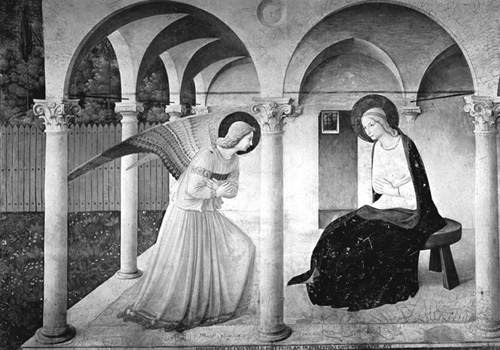

FLORENTINES ARE SO WILD ABOUT Mary they’ve always celebrated their New Year on her Annunciation, March 25. This is the day Catholics believe the Angel Gabriel swooped down to the Virgin Mary and said, “The Divine is within you!” telling her that she was pregnant with the Savior of the World.
These days there’s partying to celebrate the event in the piazza of the Church of the Most Holy Annunciation (Santissima Annunziata), where a thirteenth-century miracle is believed to have taken place. An artist (some say Pietro Cavallini) was painting a fresco of the Annunciation, and felt so overwhelmed when he got to the face, he stepped away and fell into a deep sleep. When he woke up, the painting was finished. (There’s a universal dream of every artist if I’ve ever heard one.) The Annunciation fresco is to the left of the church entrance in an ornate tabernacle, and Florentine brides traditionally visit it to drop off their bouquets.
Besides the Chiesa Santissima Annunziata, Florence is chock-a-block with Annunciations. Renaissance painters loved interpreting the action-packed scene and the variations you’ll see all over the city go from austere to absolutely flirty. I’m partial to Pontormo’s Mannerist one in Santa Felicitá, where Mary’s a willowy figure with a rose robe swirling about her, like a runway model.
The most famous Annunciation painting can be found in Museo San Marco. The Dominican Friars of this fifteenth-century monastery were very lucky to have a talented painter in their gang, Guido di Pietro. He was such a great guy, they named him Fra Angelico, which means Brother Angel. This Fra Angelico is not to be confused with the monk from northern Piedmont, for whom the hazelnut liqueur is named.
 This Fra Angelico (now called Beato Angelico) spent eight years with his assistants frescoing San Marco’s hallways and monks’ cells, with images to support them in their meditation and prayer. He was so spiritually on fire, he prayed every time he picked up a brush, never changed what he’d done (thinking it would insult the Divine who gave him inspiration), and wept every time he painted a crucifixion. The frescos here, painted over gold backgrounds downstairs and in muted jewel tones upstairs, clearly reflect his deep faith and humility.
This Fra Angelico (now called Beato Angelico) spent eight years with his assistants frescoing San Marco’s hallways and monks’ cells, with images to support them in their meditation and prayer. He was so spiritually on fire, he prayed every time he picked up a brush, never changed what he’d done (thinking it would insult the Divine who gave him inspiration), and wept every time he painted a crucifixion. The frescos here, painted over gold backgrounds downstairs and in muted jewel tones upstairs, clearly reflect his deep faith and humility.
On your way up the stairs to the cells, you’ll turn on a landing and get hit with the sight of his most well-known Annunciation, which has been called the most beloved painting of the Renaissance. It’s been reproduced so many times you’ll get that weird brain readjustment that happens when suddenly you’re in front of the real thing. Stay on that landing, with the stairs ahead of you to get the viewpoint Fra Angelico intended.
Peaceful power! Mary is timid, leaning forward with her hands crossed over her heart in acceptance. In its soft, luminous style, the moment of her transformation is striking. Taking in the whole image, you’ll realize Fra Angelico’s message. He included the beams of the house, to ground the event in reality. At the same time the figures are totally out of proportion—as tall as the pillars and doors that surround them, so the expansive nature of the moment is palpable.
In Cell Number 3, believed to be Fra Angelico’s, is a simpler Annunciation. There Saint Dominic, the monks’ patron, stands in a corner. It’s as if the painter, through the saint, was teaching the monks to contemplate this image of humility.
In 1982, Pope John Paul officially beatified Fra Angelico, praising the divine beauty he painted, and putting him on the path to become the Patron Saint of Artists.
Also in the Museo are beautiful paintings of Madonnas and female saints by other Fras. Two very memorable ones of the Virgin and Child by Fra Bartolomeo have been placed in one of the cells that belonged to Savonarola, the fanatic friar who inspired masterpieces to be burned in the famous 1497 Bonfire of the Vanities. Go figure.
Museo San Marco: Piazza San Marco, weekdays 8:15-1:50, weekends 8:15-4:15, closed first, third, and fifth Sundays, and second and fourth Mondays of the month (www.polomuseale.firenze.it)

Golden Day: Visit San Marco in the morning, when the light is best for viewing the frescos. Then have lunch at Trattoria Mario (Via Rosina 2r, closed Sunday, no reservations), a great folksy place near the Mercato Centrale.
TIP: Though the artwork here is amazing, this is a Florence museum that is not overcrowded.